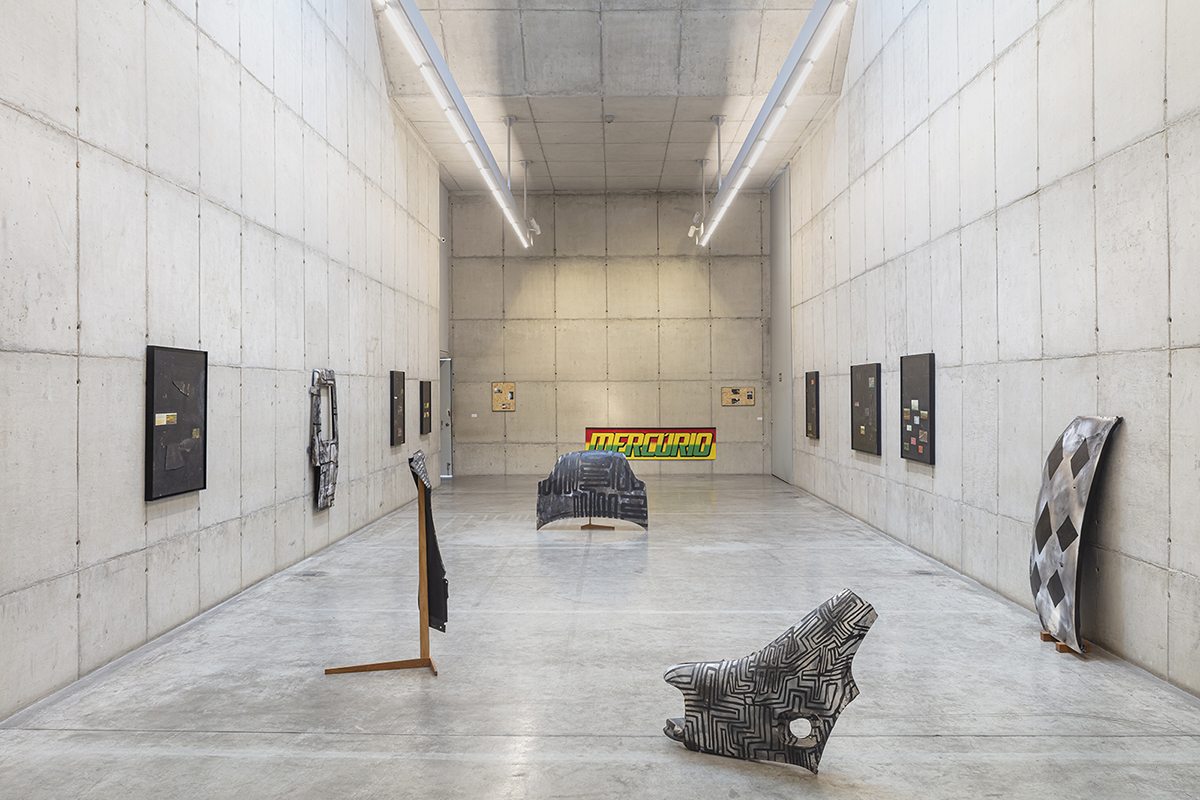Saturday, September 19th, 2020, virtually opens the solo exhibition Terra de Ninguém by artist Frederico Filippi at Galeria Leme. Curated by Thais Rivitti, the exhibition shows a selection of recent works by the artist, divided into three groups: eight untitled paintings, works from the Seiva series and the installation Carne de Caça. The first exhibition to open in the gallery space after the closure due to the Covid-19 pandemic – and still under special conditions of visitation – the exhibition reflects on the relationship of man with the environment in which he lives, focusing, above all, on Brazilian issues within this context.
The eight new paintings, with varying dimensions, bring small landscapes that show a changing nature. They are somewhat nebulous images, made with the mediation of photographic reproductions, which open on a black background. The support for the paintings is not the white canvas commonly used by painters, but a black rubber plate. The material brings with it, at the same time, the memory of natural latex and the industrial process that transforms the raw material into a product ready for consumption.
The works in the Seiva series show trucks’ lameirões (also made with the same black rubber as the paintings) that the artist orders with the words “fire”, “gold” and “mercury”. They are “objects-paintings” that are born with the vocation of traveling Brazil in trucks that travel along the highways, transporting the most diverse loads. In the gallery, these objects condense, in some way, the route of the roads making us think about the possible encounters of these “words – signs – elements” with the landscape they cross.
The installation Carne de Caça, gathers parts of a burnt car on which the artist draws with asphalt. This dismembered carcass is recomposed again in the gallery, somewhat reminiscent of the montages of extinct animals in Natural History museums. The designs of these patterns on the surface of the pieces evoke the skin of some mammals, creating, again, an unexpected intersection between the machine (the car, the industry) and the living body (the animal, nature).
One of the most provocative artists of his generation, Frederico Filippi has built a work that asks about the consequences of predatory actions on nature, about the annihilation of traditional ways of life, about a narrowing of the world view resulting from the hegemony of white thought, western and scientific in different fields of knowledge. His work links current events with long historical processes, such as the colonization of the American territory. Articulating economic, symbolic and political processes, the artist’s work brings to light the main impasses placed to think about the present.
________________________________________________________________________
About the artist:
Frederico Filippi. São Carlos, Brazil, 1983. Lives and works in São Paulo, Brazil.
With various procedures and scattered techniques, the centrality of these images in his investigations often arise from the influence received from anthropological topics – specifically the Amerindian ethnology – as a field of research, imagistic waste from the meeting of different worlds and the diagramming of apparently chaotic information in a new context. For this, while focusing on objects and materials to produce paintings, drawings and installations he also carries out more extensive research on displacement processes and residencies that end up producing an action on reality, even if very small, so to introduce a noise in the overall image. Increasingly the invisible agency of objects and information have become a meeting point in his process, so that the artist does not befalls vertically on a technique but moves according to his survey and finds in different materials and actions ways to make visible these procedures.
Solo shows: Cobra Criada, Galeria Athena, Rio de Janeiro, Brazil (2019); O sol, o jacaré albino e outras mutações, Galeria Athena Contemporânea, Rio de Janeiro, Brazil; Fogo na Babilônia, Pivô, São Paulo, Brazil; Desvío, KIOSKO, Santa Cruz de la Sierra, Bolívia (2015); Deuses Impostores, IBEU- Rio de Janeiro, Brazil (2014).
Group shows: Triangular: arte deste século, Casa Niemeyer, Brasília, Brazil; O Que Não É Floresta É Prisão Política, Galeria Reocupa – Ocupação 9 de Julho, São Paulo, Brazil (2019); ⦿, Galeria Leme, São Paulo, Brazil; Com o ar pesado demais para respirar, Galeria Athena Contemporânea, Rio de Janeiro, Brazil; Caixa-Preta, Fundação Iberê Camargo, Porto Alegre, Brazil; Que barra, Ateliê 397, São Paulo, Brazil; ROCESSOS EM TRÂNSITO | Livros de Artista 2018, Galeria da Câmara de Matosinhos, Matosinhos, Portugal (2018); IN MEMORIAM, Caixa Cultural, Rio de Janeiro, Brazil (2017); Próprio-impróprio, Galeria Leme, São Paulo, Brazil; Photo Biennale, Cities and Memory, Bienal de Fotografia e Filme, Brandts, Denmark; Totemonumento, Galeria Leme, São Paulo, Brazil (2016); Aparição, Caixa Cultural, Rio de Janeiro, Brazil; Até Aqui Tudo Bem, Inside the White Cube, White Cube, São Paulo, Brazil (2015); among others.
Awards and artistic residencies: Intervalo-Escola: Intervalo em curso, Casa do Rio e Reserva de Desenvolvimento Sustentável Igapó Açu, Amazônia, Brazil (2017); Kiosko, Santa Cruz de la Sierra, Bolívia; El Ranchito Matadero, Madrid, Spain (2015); Bolsa Pampulha, Museu da Pampulha, Belo Horizonte, Brazil; Prêmio Novíssimos, Galeria IBEU, Rio de Janeiro, Brazil; La Ene, Buenos Aires, Argentina (2013); 5º RedBull House of Art, São Paulo, Brazil (2011).
His work is part of the collection of MAR – Museu de Arte do Rio, Rio de Janeiro, Brazil and Casa da Cultura da América Latina na Universidade de Brasília, Brazil.






















